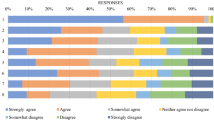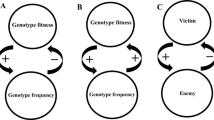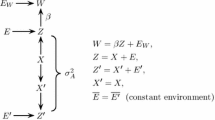Abstract
In this article we argue that the classical—linear and bottom-up directed—models of causation in biology, and the “proximate/ultimate” dichotomy, are inappropriate to capture the complexity inherent to biological processes. We introduce a new notion of “multilevel causation” where old dichotomies such as proximate/ultimate and bottom-up/top-down are reinterpreted within a multilevel, web-like, approach. In briefly reviewing some recent work on complexity, EvoDevo, carcinogenesis, autocatalysis, comparative genomics, animal regeneration, phenotypic plasticity, and niche construction, we will argue that such reinterpretation is a necessary step for the advancement of the “Extended Synthesis.”



Similar content being viewed by others
Notes
Multilevel causation is fundamental in organization processes of biological complexity: in areas of study such as complexity theory (Kauffman 1993; Emmeche et al. 2000; Hooker 2011), niche construction theory (Gilbert and Sarkar 2000; Laland et al. 2008), epigenesis (Newman 2003b), paleontology (Vrba and Eldredge 1984; Sepkoski 2008), systems biology (Palsson 2006; Trewavas 2006), cellular autocatalysis (Moreno and Umerez 2000), neurobiology (Ellis 2009), and evolutionary theory (Campbell 1974; Mitchell 2009; Martínez and Moya 2011), there are many advanced works about the importance of the co-determination of bottom-up and top-down causes. This co-determination is seen as a universal pattern of organization (El-Hani and Queiroz 2005).
It is worth mentioning that several philosophers (e.g., Kim 1998; Craver and Bechtel 2007) call into question the notion of top-down or downward causation, arguing that it presents important difficulties in its conceptualization. But see Andersen et al. (2000) and Klister (2010) for a defense of downward causation’s concept.
Such is the case of the female goldenrod gallfly. The proteins contained in the saliva of the gallfly larva induce a cellular proliferation on the goldenrod. A gall is formed and the larva enters in it and continues to be protected as it feeds.
References
Amundson R (2005) The changing role of the embryo in evolutionary thought. Cambridge University Press, Cambridge
Andersen PB, Emmeche C, Finnemann NO et al (2000) Downward causation: minds, bodies, and matter. Aarhus University Press, Aarhus
Bolker JA (2000) Modularity in development and why it matters to evo-devo. Amer Zool 40:770–776
Brigandt I (2007) Typology now: homology and developmental constraints explain evolvability. Biol Philos 22:709–725
Callebaut W, Müller GB, Newman SA (2007) The organismic systems approach: streamlining the naturalistic agenda. In: Sansom R, Brandon RN (eds) Integrating evolution and development: from theory to practice. MIT Press, Cambridge, pp 25–92
Campbell DT (1974) Downward causation in hierarchically organised biological systems. In: Ayala FJ, Dobzhansky T (eds) Studies in the philosophy of biology. MacMillan, London, pp 179–186
Craver CF, Bechtel W (2007) Top-down causation without top-down causes. Biol Philos 22:547–563
Davidson EH (1993) Later embryogenesis: regulatory circuitry in morphogenetic fields. Development 118:665–690
Dickins TE, Barton RA (2013) Reciprocal causation and the proximate–ultimate distinction. Biol Philos 28:747–756
Dupré J (2012) Processes of life: essays in the philosophy of biology. Oxford University Press, Oxford
El-Hani C, Queiroz J (2005) Downward determination. Abstracta 1:162–192
Ellis GFR (2006) Physics and the real world. Found Phys 36:227–262
Ellis GFR (2009) Top-down causation and the human brain. In: Murphy N, Ellis G, O’Connor T (eds) Downward causation and the neurobiology of free will. Springer, Berlin, pp 63–81
Emmeche C, Køppe S, Stjernfelt F (2000) Levels, emergence, and three versions of downward causation. In: Andersen PB, Emmeche C, Finnemann NO, Christiansen PV (eds) Downward causation. Aarhus University Press, Aarhus
Esposito M (2013) Romantic biology—1890–1945. Pickering and Chatto, London
Gilbert SF (1997) The “re-discovery” of morphogenetic fields. DevBio: a companion to Developmental Biology, 8th edn. Sinauer, Sunderland. http://8e.devbio.com/article.php?ch=3&id=18
Gilbert SF (2002) Predator-induced polyphenism. In: Tickle C (ed) The encyclopedia of life sciences, vol 15. Macmillan, London, pp 134–138
Gilbert SF (2003) The reactive genome. In: Müller GB, Newman SA (eds) Origination of organismal form: beyond the gene in developmental and evolutionary biology. MIT Press, Cambridge, pp 87–101
Gilbert SF, Sarkar S (2000) Embracing complexity: organicism for the 21st century. Dev Dynam 219:1–9
Gilbert SF, Opitz JM, Raff RA (1996) Resynthesizing evolutionary and developmental biology. Dev Biol 173:357–372
Gottlieb G (1992) Individual development and evolution: the genesis of novel behavior. Oxford University Press, Oxford
Hall B (2000) Evo-devo or devo-evo—does it matter? Evol Dev 2:177–178
Hamburger V (1980) Embryology and the modern synthesis in evolutionary theory. In: Mayr E, Provine W (eds) The evolutionary synthesis: perspectives on the unification of biology. Cambridge University Press, New York, pp 97–112
Hamburger V (1988) The heritage of experimental embryology: Hans Spemann and the organizer. Oxford University Press, Oxford
Hooker C (2011) Philosophy of complex systems. North Holland Elsevier, Amsterdam
Huang S (2000) The practical problems of post-genomic biology. Nat Biotechnol 18:471–472
Kauffman SA (1993) The origins of order. Oxford University Press, Oxford
Kim J (1998) Mind in a physical world. MIT Press, Cambridge
Klister M (2010) Causation across levels, constitution, and constraint. In: Suárez M, Dorato M, Rédei M (eds) EPSA Philosophical issues in the sciences. Springer, Berlin, pp 141–151
Laland KN, Odling-Smee J, Gilbert SF (2008) EvoDevo and niche-construction: building bridges. J Exp Biol Mol Dev Evol 310B:1–18
Laland KN, Sterelny K, Odling-Smee J et al (2011) Cause and effect in biology revisited: is Mayr’s proximate-ultimate dichotomy still useful? Science 334:1512–1516
Laland KN, Odling-Smee J, Hoppitt WJE et al (2013) More on how and why: cause and effect in biology revisited. Biol Philos 28:719–745
Laubichler MD, Maienschein J (2007) Embryos, cells, and organisms: reflections on the history of evolutionary developmental biology. In: Sansom R, Brandon RN (eds) Integrating evolution and development. MIT Press, Cambridge, pp 1–24
Lee D, Severin K, Gadhiri M (1997) Autocatalytic networks: the transition from molecular self-replication to molecular ecosystems. Curr Opin Chem Biol 1:491–966
Levin M (2012) Morphogenetic fields in embryogenesis, regeneration, and cancer: non-local control of complex patterning. BioSystems 109:243–261
Levins R, Lewontin RC (1985) The dialectical biologist. Harvard University Press, Cambridge
Love A (2003) Evolutionary morphology, innovation, and the synthesis of evolutionary and developmental Biology. Biol Philos 18:309–345
Love A (2006) Evolutionary morphology and evo-devo: hierarchy and novelty. Theory Biosci 124:317–333
Martínez M (2011) EvoDevo, complexity and multilevel causation. In: Martínez-Contreras J, Ponce A (eds) Darwin’s evolving legacy. Siglo XXI, Mexico City
Martínez M, Moya A (2011) Natural selection and multi-level causation. Philos Theory Biol 3:e202
Mayr E (1961) Cause and effect in biology. Science 134:1501–1506
Merhej V, Raoult D (2012) Rhizome of life, catastrophes, sequence exchanges, gene creations, and giant viruses: how microbial genomics challenges Darwin. Front Cell Infect Microbiol 2:113
Mesoudi A, Blanchet S, Charmantier A et al (2013) Is non-genetic inheritance just a proximate mechanism? A corroboration of the extended evolutionary synthesis. Biol Theory 7:189–195. doi:10.3389/fcimb.2012.00113
Mitchell SD (2009) Unsimple truths: science, complexity, and policy. University of Chicago Press, Chicago
Miyakawa H, Imai M, Sugimoto N et al (2010) Gene up-regulation in response to predator kairomones in the water flea, Daphnia pulex. Dev Biol 10:45
Moreno A, Umerez J (2000) Downward causation at the core of living organization. In: Andersen PB, Emmeche C, Finnemann NO et al (eds) Downward causation. Aarhus University Press, Aarhus
Müller GB (2005) Evolutionary developmental biology. In: Wuketits FM, Ayala FJ (eds) Handbook of evolution. Wiley, Weinheim, pp 87–115
Müller GB (2007) Six memos for evo-devo. In: Laubichler MD, Maienschein J (eds) From embryology to evo-devo. MIT Press, Cambridge, pp 459–524
Müller GB, Newman SA (2003) Origination of organismal form: the forgotten cause in evolutionary theory. In: Müller GB, Newman SA (eds) Origination of organismal form. MIT Press, Cambridge, pp 3–10
Müller GB, Olsson L (2003) Epigenesis and epigenetics. In: Hall BK, Olson W (eds) Keywords and concepts in evolutionary developmental biology. Harvard University Press, Cambridge, pp 114–123
Newman SA (2003a) From physics to development: the evolution of morphogenetic mechanisms. In: Müller GB, Newman SA (eds) Origination of organismal form. MIT Press, Cambridge, pp 221–239
Newman SA (2003b) Hierarchy. In: Hall BK, Olson W (eds) Keywords and concepts in evolutionary developmental biology. Harvard University Press, Cambridge, pp 169–174
Newman SA, Forgacs G, Müller G (2006) Before programs: the physical origination of multicellular forms. Int J Dev Biol 50:289–299
Noble D (2006) The music of life: biology beyond genes. Oxford University Press, Oxford
Noble D (2013) Physiology is rocking the foundations of evolutionary biology. Exp Physiol 98:1235–1243
Odling-Smee FJ, Laland KN, Feldman MW (2003) Niche construction: the neglected process in evolution. Princeton University Press, Princeton
Olsson L, Levit GS, Hoßfeld U (2010) Evolutionary developmental biology: its concepts and history with a focus on Russian and German contributions. Naturwissenschaften 97:951–969
Palsson B (2006) Systems biology: properties of reconstructed networks. Cambridge University Press, Cambridge
Passera L, Roncin E, Kaufmann B et al (1996) Increased soldier production in ant colonies exposed to intraspecific competition. Nature 379:630–631
Pigliucci M, Müller GB (eds) (2010) Evolution: the extended synthesis. MIT Press, Cambridge
Plutynski A (2008) Explaining how and explaining why: developmental and evolutionary explanations of dominance. Biol Philos 23:363–381
Raoult D, Koonin EV (2012) Microbial genomics challenge Darwin. Front Cell Infect Microbiol 2:127
Reif WE, Junker T, Hoßfeld U (2000) The synthetic theory of evolution: general problems and the German contribution to the synthesis. Theory Biosci 119:41–91
Riedl R (2005) A systems theory of evolution. In: Hösle V, Illies C (eds) Darwinism and philosophy. University of Notre Dame Press, Notre Dame, pp 121–143
Sepkoski D (2008) Macroevolution. In: Ruse M (ed) Oxford handbook of philosophy of biology. Oxford University Press, Oxford, pp 211–237
Soto A, Sonnenschein C (2005) Emergentism as a default: cancer as a problem of tissue organization. J Biosci 30:103–118
Spemann H (1919) Experimentelle forschungen zum determinations- und individualitätsproblem. Naturwissenschaften 7:581–591
Strohman RC (2000) Organization becomes cause in the matter. Nat Biotechnol 18:575–576
Thierry B (2005) Integrating proximate and ultimate causation: just one more go! Curr Sci 89:1180–1184
Trewavas A (2006) A brief history of systems biology. Plant Cell 18:2420–2430
van Der Weele C (1999) Images of development: environmental causes in ontogeny. SUNY Press, Albany
Vrba E, Eldredge N (1984) Individuals, hierarchies and processes: towards a more complete evolutionary theory. Paleobiology 10:146–171
Weider LJ, Pijanowska J (1993) Plasticity of Daphnia life histories in response to chemical cues from predators. Oikos 67:385–392
West-Eberhard MJ (2003) Developmental plasticity and evolution. Oxford University Press, New York
West-Eberhard MJ (2005) Developmental plasticity and the origins of species differences. Proc Natl Acad Sci USA 102:6543–6549
Woodger JH (1929) Biological principles: a critical study. Kegan Paul, Trench, Trubner, London
Acknowledgments
We are grateful to all the members of PhiBio, Seminario de Filosofía de la Biología UAM-C, for useful discussions.
Author information
Authors and Affiliations
Corresponding author
Rights and permissions
About this article
Cite this article
Martínez, M., Esposito, M. Multilevel Causation and the Extended Synthesis. Biol Theory 9, 209–220 (2014). https://doi.org/10.1007/s13752-014-0161-3
Received:
Accepted:
Published:
Issue Date:
DOI: https://doi.org/10.1007/s13752-014-0161-3




